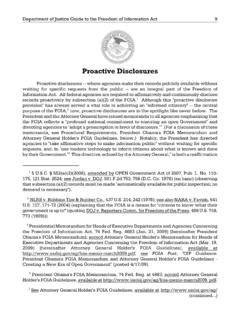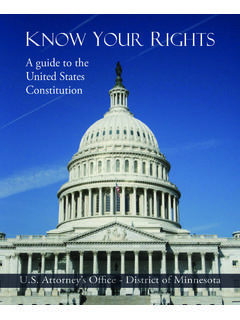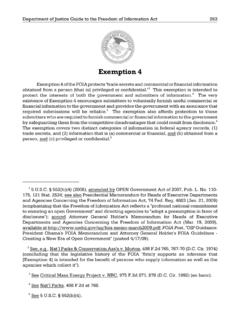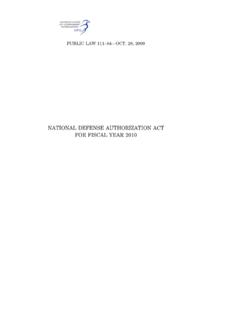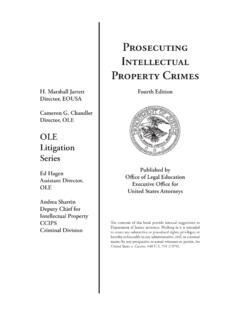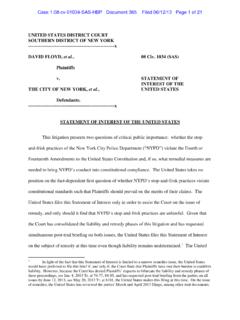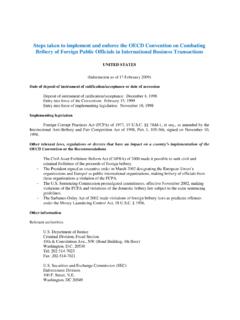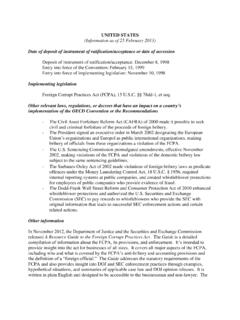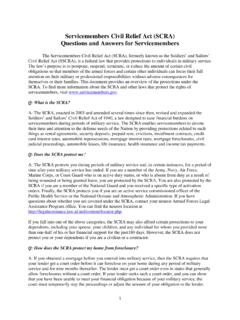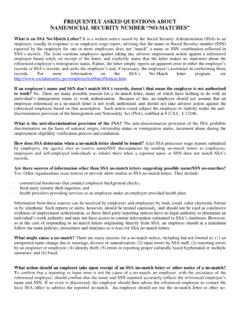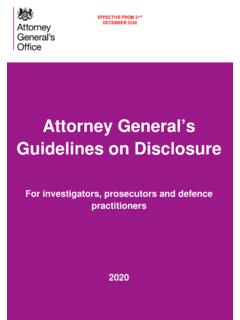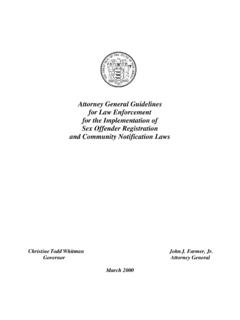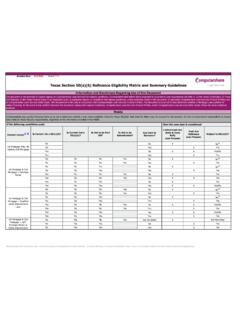Transcription of Attorney General Guidelines for Victim and Witness Assistance
1 Department of Justice Office of Justice Programs Office for Victims of Crime 2011 EDITION E F F E C T I V E O C T O B E R 1 , 2 0 1 1 Department of Justice Office of Justice Programs 810 Seventh Street NW. Washington, DC 20531 Eric H. Holder, Jr. Attorney General Laurie O. Robinson Assistant Attorney General Joye E. Frost Acting Director, Office for Victims of Crime Office of Justice Programs Innovation Partnerships Safer Communities Office for Victims of Crime NCJ 235121 October 2011 The Office of Justice Programs (OJP), headed by Assistant Attorney General Laurie O. Robinson, provides federal leadership in developing the Nation s capacity to prevent and control crime, administer justice, and assist victims. OJP has six components: the Bureau of Justice Assistance ; the Bureau of Justice Statistics; the National Institute of Justice; the Office of Juvenile Justice and Delinquency Prevention; the Office for Victims of Crime; and the Office of Sex Offender Sentencing, Monitoring, Apprehending, Registering, and Tracking.
2 More information about OJP can be found at i 2 0 1 1 E d i t i o n Foreword Our core mission is to pursue justice for criminal acts, and that pursuit includes justice for the victims of and witnesses to crime. Every day, Department personnel encounter individuals harmed by crime or who witnessed others being harmed by crime. How we treat those indi-viduals has a huge impact on their confidence in the criminal justice system and their ability to heal and recover from crime. When the Department is successful in identifying and convict-ing offenders, our Victim Assistance efforts help victims navigate an unfamiliar system, foster accountability, and find affirmation for their suffering. In situations where the Department is unable to identify a perpetrator or bring a perpetrator to justice, our outreach and Assistance can help victims access the services they need to recover and help them understand the criminal justice response.
3 For several decades, crime victims laws have mandated that Department personnel provide victims with services and make our best efforts to see that victims are accorded their rights. To satisfy our statutory responsibilities, it is essential that Department personnel understand the legal mandates regarding victims and receive clear guidance about how to carry out those responsibilities. This updated edition of the Attorney General Guidelines for Victim and Witness Assistance reflects current statutory provisions, recognizes the technological and legal changes that have taken place since the previous Guidelines were promulgated, and incorporates best practices that will benefit victims and enhance investigations and prosecutions. It is my hope that this tool will enhance our ability to vindicate victims rights and to provide victims with the services that they deserve. Eric H. Holder, Jr. Attorney General of the United States [page intentionally left blank] iii 2 0 1 1 E d i t i o n Contents Foreword.
4 I Article I: General Considerations .. 1 A. Statement of Purpose .. 1 B. How To Apply These Guidelines .. 1 Article II: Guidelines Applicable to All Components .. 3 A. Encouragement To Provide Services and Assistance .. 3 B. Victim Declinations of Services and Exercise of Rights .. 3 C. Privacy and Confidentiality Considerations for Victims and Witnesses .. 3 D. Mandatory Training .. 4 E. Mandatory Reporting of AG Guidelines Compliance .. 5 F. AG Guidelines Compliance Measures .. 5 G. Performance Appraisal .. 5 Article III: Who Is a Victim .. 7 A. Introduction .. 7 B. Victim Services Definition (VRRA Definition) .. 7 C. Enforceable Victims Rights Definition (CVRA Definition) .. 8 D. Harm .. 8 E. Other Persons Affected by a Crime .. 11 F. Culpability .. 11 G. Government Entities .. 12 H. Victims in a Foreign Country and Foreign Nationality Victims .. 12 I. Foreign Proceedings.
5 13 J. Victims of Juvenile Offenders .. 13 K. Large Numbers of Victims .. 14 L. Particularly Vulnerable Victims .. 14 Article IV: Mandatory Services .. 25 A. Background .. 25 B. Responsible Officials .. 25 C. Timing of Services .. 26 D. Coordination of 26 iv Attorney General Guidelines for Victim and Witness Assistance E. Victim Identification .. 27 F. Reasonable Protection .. 27 G. General Information .. 28 H. Services Referrals .. 29 I. Notice of Case Events .. 30 J. Separate Waiting Area .. 32 K. Return of Property .. 32 L. Employer/Debt 33 Article V: Victims Rights Under the CVRA .. 35 A. Background .. 35 B. Responsibilities of Department Personnel .. 35 C. Right to Reasonable Protection .. 37 D. Right to Reasonable, Accurate, and Timely Notice .. 37 E. Right Not To Be Excluded From Court .. 39 F. Right To Be Reasonably Heard .. 40 G. Reasonable Right To Confer With the Prosecutor.
6 41 H. Right to Full and Timely Restitution as Provided in Law .. 42 I. Right to Proceedings Free From Unreasonable Delay .. 47 J. Right to Fairness and Respect for Dignity and Privacy .. 47 K. In-Court Enforcement Mechanisms .. 48 Article VI: Witnesses .. 51 A. Victims Services and Rights Laws Do Not Cover Witnesses .. 51 B. Witness Security .. 51 C. Logistical Assistance .. 52 D. Notification of Offender Release .. 52 Article VII: Non-Litigability .. 53 Appendixes .. 55 A. Victims Rights and Restitution Act .. 55 B. Crime Victims Rights Act .. 59 1 2 0 1 1 E d i t i o n ARTICLE I General ConsIderAtIons A. Statement of Purpose The purpose of this document, the Attorney General Guidelines for Victim and Witness Assis-tance (AG Guidelines ), is to establish Guidelines to be followed by officers and employees of the Department of Justice (Department) investigative, prosecutorial, correctional, and parole components in the treatment of victims of and witnesses to crime.
7 In 1982, Con-gress directed the Attorney General to promulgate the first AG Guidelines , which have been revised periodically to reflect changes in the law. (See 18 1512 note (1984) (Federal Guidelines for Treatment of Crime Victims and Witnesses in the Criminal Justice System)). These AG Guidelines supersede the Attorney General Guidelines for Victim and Witness Assistance (2005 ed.). B. HowTo Apply These Guidelines 1. Underlying Authorities Federal victims services and rights laws are the foundation for the AG Guidelines . The core statutes are the Victims Rights and Restitution Act (VRRA), 42 10607 (2006) (containing mandatory services), and the Crime Victims Rights Act (CVRA), 18 3771 (2006 & Supp. III 2009) (containing court enforceable rights), but addi-tional rights and requirements exist in other statutes and rules of criminal procedure. In the text of the AG Guidelines , all statutory requirements or rules of criminal procedure are followed by a direct citation to the applicable statute or rule.
8 Guidelines that are purely Department policy, as opposed to statutory law, will not be followed by a citation. Guidelines that are policy intended to implement a statutory right, provision, or proce-dural rule will be followed by a citation referring to the statute or rule. 2. Obligation Definitions The AG Guidelines use the word shall where shall appears in a statute or when the policy is mandatory. The use of the term shall means that the relevant guideline is mandatory, though room may remain for individual judgment in determining how best to comply with the guideline. When the AG Guidelines use the word should, personnel are expected to take the action or provide the service described unless there is an ap-propriate, articulable reason not to do so. When the AG Guidelines use the word may, personnel are permitted to use their discretion about whether and how to provide assis-tance. Other language may be used in the AG Guidelines to describe the obligations of personnel; phrases such as are encouraged or make reasonable efforts are intended to have their usual and customary meaning.
9 2 Attorney General Guidelines for Victim and Witness Assistance 3. Coverage The AG Guidelines apply to all personnel in the Department who are engaged in or support investigative, prosecutorial, correctional, or parole functions within the crimi-nal justice system. They apply to staff regardless of title, grade, or job description who have contact with victims or take actions that impact victims. Department managers should require all contractors whose employees come into contact with crime victims to provide employee training on AG Guidelines compliance. Department components should encourage non-Department personnel specially assigned or deputized to work with Department components to learn and comply with federal victims services and rights laws and the AG Guidelines . The AG Guidelines are intended to serve as a model for Guidelines on the fair treatment of crime victims and witnesses for other state and federal law enforcement agencies.
10 4. Organization The AG Guidelines are organized around the two primary crime victims services and rights laws. Articles I and II deal with General policies affecting all components and victims. Article III contains the basic definitions of Victim under both of the key laws, as well as sections on unique Victim populations. Article IV covers the Department s mandatory obligations to provide services to victims of a crime under the VRRA. Article V covers the CVRA provisions that victims of a charged offense can enforce during a prosecution. Article VI addresses witnesses only. Article VII consists of the Department s statement on non-litigability. 3 2 0 1 1 E d i t i o n ARTICLE II Guidelines APPLICABLe to ALL CoMPonents A. EncouragementTo Provide Services and Assistance A strong presumption exists in favor of providing, rather than withholding, Assistance and services to victims of crime.
